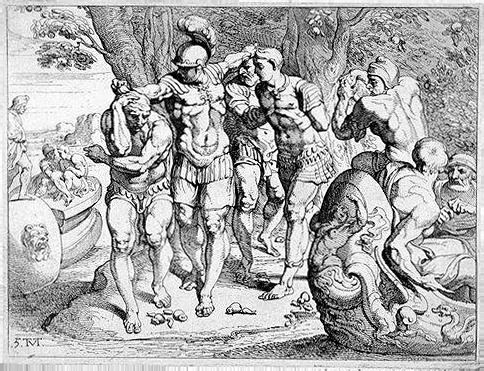 | ||
In Greek mythology the lotus-eaters (Greek: λωτοφάγοι, lōtophagoi), also referred to as the lotophagi or lotophaguses (singular lotophagus /ləˈtɒfəɡəs/) or lotophages (singular lotophage /ˈloʊtəfeɪdʒ/), were a race of people living on an island dominated by lotus plants. The lotus fruits and flowers were the primary food of the island and were narcotic, causing the people to sleep in peaceful apathy.
Contents
Mythology
In the Odyssey IX, Odysseus tells how adverse north winds blew him and his men off course as they were rounding Cape Malea, the southernmost tip of the Peloponnesus, headed westwards for Ithaca:
"I was driven thence by foul winds for a space of 9 days upon the sea, but on the tenth day we reached the land of the Lotus-eaters, who live on a food that comes from a kind of flower. Here we landed to take in fresh water, and our crews got their mid-day meal on the shore near the ships. When they had eaten and drunk I sent two of my company to see what manner of men the people of the place might be, and they had a third man under them. They started at once, and went about among the Lotus-eaters, who did them no hurt, but gave them to eat of the lotus, which was so delicious that those who ate of it left off caring about home, and did not even want to go back and say what had happened to them, but were for staying and munching lotus with the Lotus-eaters without thinking further of their return; nevertheless, though they wept bitterly I forced them back to the ships and made them fast under the benches. Then I told the rest to go on board at once, lest any of them should taste of the lotus and leave off wanting to get home, so they took their places and smote the grey sea with their oars."
Location
Herodotus, in the fifth century BC, was sure that the lotus-eaters still existed in his day, in coastal Libya:
A promontory jutting out into the sea from the country of the Gindanes is inhabited by the lotus-eaters, who live entirely on the fruit of the lotus-tree. The lotus fruit is about the size of the lentisk berry and in sweetness resembles the date. The lotus-eaters even succeed in obtaining from it a sort of wine.
Polybius identifies the land of the lotus-eaters as the island of Djerba (ancient Meninx), off the coast of Tunisia. Later this identification is supported by Strabo.
The lotus plant
Because the Greek word lôtos can refer to several different plants, there is some ambiguity as to which "lotus" appears in the Odyssey. Some of the proposed species, based in part on Herodotus' assertion, include:
It is the last of these, or another member of the genus Ziziphus, that is traditionally taken to be the plant meant in the Odyssey.
